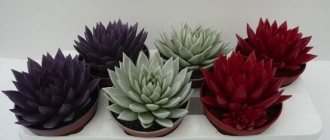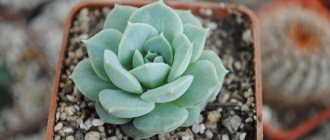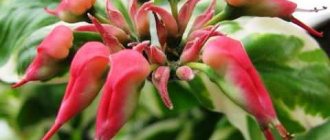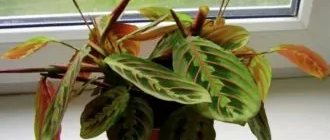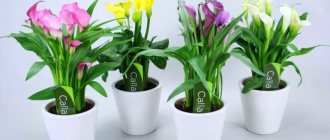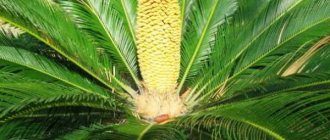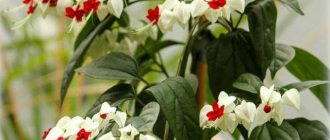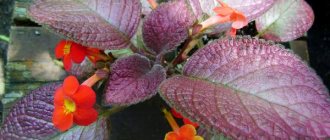Echeveria agave. Photo Echeveria or stone rose , as it is also called because of its external resemblance to the flower, is an exotic succulent plant that does not require much attention . A warm, well-lit place is the basic requirements of the plant. In return, it will add a hot desert “zest” to any interior.
It is a perennial succulent plant from the Crassulaceae family, with about 150 species. Echeveria is native to Central and South America.
The rosette, with a diameter of 10 to 40 cm, is shaped like a rose. It grows slowly: it produces several new leaves and daughter rosettes per year. The root system is superficial. Fleshy, dense leaves reach 3-20 cm in length, 1-15 cm in width, and have an oval shape with a sharp end. The leaf blade may be glossy or slightly pubescent. Depending on the species, the foliage color is green, bluish-gray, reddish or violet-pink.
| It grows slowly: it produces several new leaves and daughter rosettes per year. |
| It blooms mainly in spring or summer, some varieties in winter, for 2-3 weeks. Bell-like flowers are collected in inflorescences on a long peduncle. |
| The plant is easy to grow. |
| Perennial. |
Features of growing at home. Briefly
| Temperature | In summer – 20-27 degrees, in winter – 10-15 degrees. |
| Air humidity | Low, does not require spraying. |
| Lighting | Echeveria at home needs bright lighting; a south or south-east window sill is suitable. |
| Watering | Moderate in summer - once a week, scanty in winter - once a month. |
| Priming | Light sand mixture, well permeable to air and moisture; substrate for succulents. |
| Feeding and fertilizer | During the growing season, apply fertilizer for cacti once a month. |
| Transfer | Young specimens once a year in the spring, adults - once every 3-4 years. |
| Reproduction | Daughter rosettes, leaf cuttings, seeds. |
| Features of cultivation | The leaves are very fragile; in summer it is useful to take the plant out into the fresh air. |
Caring for echeveria at home. Details
Echeveria agave.
Photo Caring for echeveria indoors is simple and not burdensome. The main condition is to take care of the plant due to its fragile leaves with a thin protective shell, which is very easy to damage. Therefore, it is better to minimize any contact with the flower.
Bloom
Most echeveria bloom for 2-4 weeks in spring and summer .
The rosette produces a long (up to 70 cm) lateral or vertical peduncle with small bell-like flowers collected in inflorescences. The color of the petals depends on the level of illumination: in dim light - yellow, in bright light - orange or red. After flowering, babies may form at the end of the peduncle.
Temperature
The plant loves warmth. The optimal temperature for it in summer is 20-27 degrees, in winter – 10-15 degrees, but not lower than 6. For species that bloom in winter, the temperature should be maintained at 18-20 degrees.
The leaves of the plant are very sensitive to cold and frost; under their influence, the rosette significantly worsens its appearance.
Therefore, it is important to protect the stone rose from frosty air when ventilating in winter.
Spraying
Indoor echeveria prefers low air humidity and feels great even next to operating heating devices. Therefore, there is no need for spraying or any other air humidification.
Lighting
Being a native of deserts and semi-deserts, she needs bright lighting; she is not afraid of even direct sunlight. The best place is a window sill facing south or southeast .
The plant can tolerate light shading, but in this case the rosette will stretch in height. In summer, it is recommended to take it out into the fresh air: onto the balcony or into the garden, taking care to protect it from rain and wind.
Watering
Being a succulent, echeveria needs moderate and even scanty watering.
In summer, the soil is moistened approximately once a week after the top layer of soil in the pot has dried out by 3-5 cm. In winter, watering is reduced to once a month. When moistening, it is important to avoid getting water on the leaves and especially inside the rosette - this can lead to rotting. After watering, pour out the remaining water in the pan. The rule applies: it is better not to top up than to overfill.
For irrigation, settled or rainwater at room temperature is used..
Pot
Since echeveria has a shallow root system, it needs a wide but shallow pot. It is optimal that its diameter is 1.5-2 cm larger than the diameter of the plant. It is imperative to have drainage holes, otherwise the roots will begin to rot as a result of stagnant moisture.
Priming
Homemade echeveria needs loose, low-nutrient soil with a neutral reaction based on sand.
Store-bought substrate for succulents is perfect. If you have the opportunity to prepare the mixture yourself, you can choose one of the options:
- 2 parts sand, one part each of leaf and turf soil;
- 2 parts coarse sand, 1 part peat, 1 part loamy soil.
To prevent root rot, you can add a little crushed charcoal to the mixture.
It is necessary to lay a layer of drainage at the bottom, which would occupy 1/3 of the pot. You can use pebbles, expanded clay, broken bricks, and clay shards as it.
Feeding and fertilizer
Echeveria does not need frequent feeding. It is enough to feed it once a month during the growing season (spring and summer) with complex fertilizer for succulents (cacti) in half the dosage.
Excess minerals can damage the plant's delicate root system.
Transfer
It is better to transplant echeveria in the spring, at which time it will more easily withstand stress and resume growth faster.
Young specimens are replanted annually, adults - as needed, every 3-4 years. They are advised to change the top layer of soil every spring.
Replanting is carried out very carefully to minimize damage to the fragile root system and leaves.
Watering before replanting should be reduced in order to replant the flower with a dry clod of soil.
Trimming
The flower does not require shaping or other special pruning. Dried lower leaves are periodically removed to preserve the decorative appearance of the plant.
If after winter the rosette has become too elongated, you can cut off the top, leaving a “stump” 3-4 cm high. This way the echeveria will rejuvenate and new shoots will begin to grow.
Rest period
Most species are dormant in winter. At this time, the plant should be kept in good light and a temperature of 8-15 degrees. Watering is reduced to 1 time per month.
Is it possible to leave without care during the holidays?
Echeveria is a very hardy plant. By placing it on a brightly lit windowsill and moderately moistening the soil, you can safely leave for 2-3 weeks without worrying about the well-being of the flower.
Echeveria - what kind of flower is it, what family does it belong to?
The succulent echeveria is a member of the Crassula family. Almost two hundred subspecies live in nature; a small part belonging to decorative varieties is grown at home.
Stone rose succulent
Brief description, history of origin or selection
Flowers can be found in Mexican, California and Peruvian lands. The name of the culture was given in honor of an artist from Mexico who describes the flora of the country - Atanasio Echeverría y Godoy.
The foliage of the succulent has a bluish-bluish tint; in the largest representatives it grows up to 25 cm in length and up to 15 cm in width. The shoots are miniature, the leaves are collected in dense rosettes. Some subspecies have a smooth surface, others have a pubescent type.
Important! In apartments you can often find Echeveria Shavian, distinguished by a pink border on the leaf blades. Gardeners pay much attention to Echeveria humpback, Agavoides, Desmet.
Reproduction
Echeveria propagates at home in two main ways: leaves and rosettes.
Echeveria leaf propagation
The lower healthy leaf is carefully torn off and dried in the open air for 2-3 hours. The leaf is then gently pressed into the echeveria soil mixture. The soil is moistened with a spray bottle. The container is covered with polyethylene or glass and placed in a well-lit, warm (25 degrees) place. The “greenhouse” is ventilated daily and moistened as necessary.
After 2-3 weeks, one or more babies should appear at the base of the leaf. Young plants can be transplanted into individual pots when the mother leaf dries out.
Reproduction by rosettes
The basal or apical rosette is cut off with a sharp knife. The lower leaves are carefully removed. The rosette is dried in the open air for 2-3 hours, then planted in slightly moistened soil for echeveria. The plant is kept at a temperature of 22-25 degrees. The young plant should take root within a month.
Reproduction methods
Echeveria can be propagated independently in several ways. It is better to carry out the procedure in early spring.
Seeds
Seeds are sown in a flat container filled with a peat-sand mixture for seedlings. There is no need to sprinkle the substrate on top of them. Cover the container with polyethylene and place it in a room with a temperature of +20-22°C. After germination, remove the polyethylene. Place the seedlings into separate pots when they have 3 true leaves.
Leaf
A leaf is separated from the bush. It is recommended to dry it during the day so that putrefactive processes do not occur in the soil later. Lay the outer side of the sheet on wet sand. Leave it for rooting at a temperature of +25 degrees. You can plant the leaf in a separate container when the roots appear.
Cuttings
Carefully remove the top from the echeveria. Remove lower leaves. Dry them for several hours in the fresh air. Prepare a mixture of 2 parts sand and 1 part turf. Sprinkle wet sand on top. Deepen the cutting into it at a slight angle. Cover the top with film. Provide bright, diffused light and a temperature of +22-24 degrees. Periodically remove the cover for ventilation. The cuttings take root very quickly, then they can be transplanted into separate pots.
Rosettes
The method is similar to propagation by cuttings. Cut off the apical rosettes from the parent plant. They need to be dried and the sections sprinkled with activated carbon. Plant in shallow pots with a substrate suitable for adult plants.
Diseases and pests
Rarely attacked by pests and diseases, this can sometimes happen due to improper care.
Here are the main problems and the reasons for their occurrence:
- The base of the rosette rots due to excessive watering.
- Yellow spots on the leaves indicate stagnation of water in the soil or a fungal disease.
- Brown spots on echeveria leaves are a fungal disease.
- The leaves have become soft, yellowed and begin to rot - moisture stagnation in the middle of the rosette.
- Stretched out - lack of lighting.
- Lost turgor - insufficient watering.
- Leaves and stems turn black - low temperature, waterlogging of the soil.
Occasionally it is affected by spider mites, aphids, and mealybugs.
Types of Echeveria domestica with photos and names
Echeveria elegans
It has a thick stem, up to 5 cm high. It produces lateral daughter rosettes. The light green leaves with a bluish waxy coating have an oblong shape. They reach 6 cm in length and 1 cm in width. The flowers are orange-red with a yellow tip.
Echeveria carnicolor
The medium-sized oblong leaves have a pink tint.
Echeveria glauca
It has waxy leaves of a gray-blue color with a pink border along the edge. They are shaped like a spoon. The lateral peduncles delight with orange flowers collected in inflorescences.
Echeveria Black Prince
Hybrid variety with red-brown foliage. The diameter of the rosette is up to 15 cm. The flowers are chocolate-red or orange on a high peduncle.
Echeveria leucotricha
Has a short stem. The diameter of the rosette is up to 15 cm. The lanceolate leaves, convex on the back side, are green in color with brown ends. The entire leaf plate is covered with thick white pile. The leaves are 6-10 cm long, 1-3 cm wide. On a peduncle up to 50 cm high, red-brown flowers are collected in inflorescences.
Echeveria fulgens Lera
The species is bushy. The mother rosette produces thick shoots with daughter rosettes at the ends. The leaf blade, up to 10 cm long and up to 4 cm wide, has a green-burgundy color and a waxy shiny coating.
Echeveria Derenbergii
It has dense rosettes, up to 6 cm in diameter. Gray-green spatulate leaves with pink tips are up to 4 cm long and up to 2 cm wide. Short peduncles (5-6 cm) with yellow-orange flowers appear from the upper axils of the leaves.
Popular types
The home flower Echeveria has a large number of varieties. Distinctive features of all types:
- May be stemless;
- Short-stemmed;
- Lodging;
- Rosettes of leaves are formed at the ends of the shoots;
- The leaves are fleshy, dense in structure, which sprout in a spiral. Also, the leaves of echeveria acquire a sessile position.
You can grow any type of echeveria at home. The plant has a large number of varieties that can be safely grown in gardeners’ apartments.
Echeveria mix
Under this name you can find a potted plant that came to you from the store, and was supplied in a set of different varieties of echeveria (see photo above). So that you understand, “Echeveria mix” is not the name of a separate variety, it is the general name of a tray with succulents, but you will have to figure out which species you got. However, this is not so difficult, because further you can get acquainted with the most popular domestic types of echeveria.
Echeveria elegans (Echeveria elegans)
Echeveria elegans / Flowering
It is a stemless plant with a central sessile rosette and several rosettes located on the sides. Lateral rosettes, as a rule, grow vertically relative to the plane of the ground. Echeveria elegans has light green leaves. Usually the leaves of this species do not change color.
Another distinctive feature of this succulent is the transparent whitish coating that covers the surface of the leaves. The succulent usually blooms from May to June, as it loves sunlight. Echeveria graceful blooms, forming a peduncle in the upper axils of the leaves with yellow flowers. Typically, the peduncle reaches a size of about 25 centimeters.
Echeveria agavoides (Echeveria agavoides)
Echeveria agave / Blooming
It is a succulent with a shortened or missing stem. The rosette of this plant is dense and wide, which is formed in the form of collected leaves. The leaves are fleshy and thick in texture. The shape changes from spade-shaped to oval, with pointed tips. The leaf sizes, as a rule, reach 5-9 centimeters in length and 5-6 centimeters in width . The color range of the succulent is changeable.
So, from a light green color, the plant turns to a red color, located mainly on the upper edge. The edge, in turn, transitions to a spiky brown point. The surface of the leaves, like that of Echeveria gracilis, is covered with a whitish coating. Flowering in this species usually occurs at the end of spring. The flowers are red-yellow in color on a long stalk, bloom in the middle of the rosette and have a peduncle size of 30 to 40 centimeters.
Also read: Stapelia - a flower similar to a cactus
Echeveria derenbergii
Echeveria Derenberga / Flowering
It is a plant with rosettes of cylindrical leaves and creeping shoots. The leaves of this species are wide with pointed tips. The leaf sizes, as a rule, reach 3-4 centimeters in length and 2 centimeters in width. Most of the surface is light green in color with a whitish coating.
The upper edge is reddish-brown. The flowering period of this species occurs in the spring and summer months. Typically, between April and June, Echeveria Derenberg produces a short and few-flowered peduncle. Once fully formed, the peduncle produces 3-5 orange flowers.
Echeveria setosa
Echeveria bristles / Flowering
It is the most favorite species of gardeners. A succulent can be either with a short stem or without a stem, sprouting only in the form of a rosette of leaves. The rosette has a dense structure with dark green leaves, which are strewn with small white bristles. The leaf blade usually has an obovate shape with a triangular apex.
The dimensions of the plate reach 7-9 centimeters in length and 2-3 centimeters in width. Flowering in this species occurs at the end of spring or at the beginning of summer. The succulent blooms quite profusely. The formed peduncle, as a rule, has a size of 30 centimeters. Two-colored, red-yellow flowers bloom. It is noted that the sepals and petals are densely pubescent.
Echeveria “Pearl of Nuremberg” (Echeveria “Perle von Nurnberg”)
Echeveria "Pearl of Nuremberg" / Bloom
A beautiful and graceful succulent that was created by crossing two species of echeveria. The hybrid has a thick and straight stem. The leaves of this species have a pink-gray or delicate scarlet color, usually at an early age. The flowers of the Nuremberg pearl are a muted scarlet color and bloom in late spring.
Echeveria gibbifiora
Echeveria hump-flowered
Of all the varieties, it differs in that it is quite similar to a tree. The stems of this plant are straight and weakly branched. Rosettes are located on the upper parts of the shoots. The leaves have a gray-green color with a brown tint; the leaf size usually reaches 20-25 centimeters in length and 10-15 centimeters in width. The leaf blade is convex at the bottom and concave at the top.
Flowering of the horned-flowered species usually occurs at the end of the summer. The formed peduncle reaches 1 meter and forms spike-shaped inflorescences. The flowers of this species are two-colored: yellow on the inside and pale scarlet on the outside.
Echeveria purpusorum
Echeveria purpuzorum
is a stemless, slow bushing succulent plant that reaches 6 centimeters in diameter. The leaves of this species have a rigid structure, with a triangular shape and a pointed tip, measuring up to 3 centimeters in length and 2.5 centimeters in width.
Flowering of Echeveria purpuzorum usually occurs in early spring. The flowers are usually collected in an inflorescence that is 20 centimeters in length. The flowers are orange-yellow in color and reach 2 centimeters in length.
Echeveria Miranda
Echeveria Miranda
One of the most popular succulents among gardeners. It is a variety of agave-like echeveria. The characteristic differences of this species are its structure and appearance. So, the plant has several rosettes that look quite calm and neat. Flower growers call the rosettes of Echeveria miranda “lying on the ground.”
In shape, these plants are similar to a lotus. This species is a hybrid, so it can have different shades of tint on the leaves. Miranda usually has bluish, purple, pink, yellow, scarlet or silver hues on its leaves.
Also read: Kalanchoe - medicinal properties, use in folk medicine, useful recipes
Echeveria Black Prince
Echeveria black prince
is a hybrid species. The leaves of this plant are green in color and have a dark purple tint at the tips. Flowering usually occurs at the end of summer, the inflorescences are of a single color, mostly scarlet, the flowers are not large in size.
Echeveria lilacina
Ehevelia lilacina
A variety of succulent that easily adapts to home growing conditions. This species has a rosette measuring about 10-40 centimeters in diameter . It is noted that over the course of a year, the plant may develop several small rosettes and new leaves. This species is not fussy to care for; in summer the flower requires a temperature of no more than 27 °C, and in winter from 7 °C to +15 °C.
Flowering usually occurs in late spring. The flowering period is 2-3 weeks, after which yellow and orange bell-shaped flowers bloom. Flowers bloom from the middle of the rosette.
Echeveria pulidonis
Echeveria pulidonis / Flowering
Echeveria pulidonis is one of the many species of the succulent family. This species has a rosette measuring 15 centimeters in diameter. The stemless plant has distinctive features, such as: leaves of an elongated and narrow shape, measuring up to 7 centimeters in length. It has a blue tint and is distinguished by a bright red edging of the leaves. Flowering occurs in summer. The peduncle, as a rule, is formed long and tall, blooms with bright yellow, bell-shaped flowers.
Echeveria shaviana
Photo: adenium-doma.ru
Also called “Echeveria SHO”. The average size of the rosette is 10 cm in diameter. The plant has spatulate leaves and a corrugated outline, which turns pink in the sun, which makes this succulent especially unusual.
Echeveria runyonii topsy-turvy
Photo: adenium-doma.ru
The succulent has beautiful, fleshy, elongated leaves with a silvery coating, which in bright sunlight becomes denser and acquires a bluish tint. Rosettes are 10-15 cm in diameter. Unpretentious in care, like all representatives of the species.
Echeveria laui
Due to the thick layer of plaque, the plant acquires a silvery-white hue. The diameter of the rosette is 10-15 cm. Recommendations for care are general, as for all echeverias, they can be found at the beginning of this article.
Echeveria Lola
Photo: adenium-doma.ru
This is a hybrid of the Lilitsina and Derenbergia species. The succulent has a beautiful rose-shaped rosette, marble-colored leaves with a white-pink bloom. The average cost of a young specimen is 300 rubles. It is not fussy about care, like other representatives of Echeveria.
Echeveria cubic frost
A distinctive feature is the leaf blades growing with the narrow part down. “Ice cube” has a bluish-lilac coating on the leaves, the rosette size is 10-20 cm. In sunlight it takes on a pink tint. The average cost of a young plant is 400 rubles.
Echeveria nodulosa or nodular (echeveria nodulosa)
An unusual bright representative of Echeveria, rosettes with a diameter of 15-20 cm, drop-shaped leaves with a burgundy outline and a painted middle. The leaves have virtually no plaque, which makes them even more expressive and brighter. Care recommendations are standard for all varieties. It blooms mainly in spring, the color of the inflorescences is red.
Echeveria pollux, pollux (echeveria pollux)
Photo: adenium-doma.ru
The pollux rosette is star-shaped and looks like an open flower, the leaves are flat, wide, with a light blue bloom and a purple outline. The succulent is drought-resistant, but requires a watering regime in the summer and winter. The cost of a young specimen is on average 250 rubles.
Echeveria affinis, black knight (Echeveria affinis)
This is a dwarf species, described back in 1958 by botanist E. Walter. The outer side of the sheet is without bends, flat in shape. Affenis stands out for its unusual color, from dark green to black-violet. It blooms in spring or autumn, producing bright red buds. Does not require special care, it is worth learning the basic principles of keeping Echeveria.
Among such a variety of species, every gardener will definitely find a plant to his liking. Happy growing!
